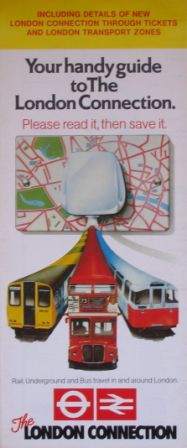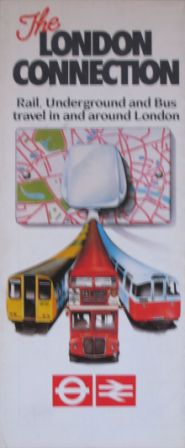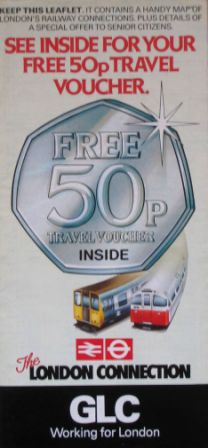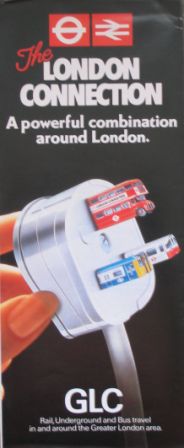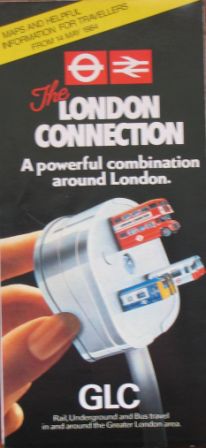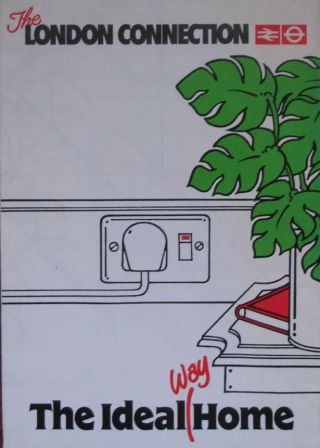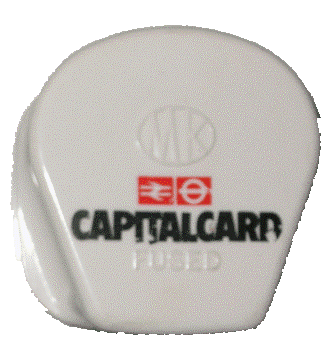British Railways Publicity
| The Story of Capitalcard | London Connections |
| Capitalcard Season Tickets | One Day Capitalcard |
| GPCC Advertising | Return to main BR(S) Site |
The Story of Capitalcard
While Capitalcard had only a brief life as a brand (launched in 1985 and superseded by new Travelcard in January
1989), it did make a significant contribution in terms of increasing travel by public transport as well as being a
splendid example of close cooperation between the marketing teams at L&SE/Network SouthEast and London Transport.
London Connections
The routes of Capitalcard can be traced back to 1982 when British Rail and London Transport agreed to work more closely
together to promote the improved integration of the two networks. The primary objective was to stimulate increased off
peak travel by creating greater awareness of the systems, the ever improving inter-change facilities at stations and
the availability of through tickets. Some sections of the network, such as the North London Line, were under utilised
and in danger of becoming ‘London‘s forgotten railways‘.
This lead to the first joint advertising campaign under the brand ‘London Connections‘. The creative strategy combined a carefully balanced logo with powerful imagery of the plug. The logo had to be clearly distinctive, yet harmonise the two organisations‘ own strongly established corporate identities. The power plug was added to symbolise the close inter-relationship between the three modes - train, tube and bus. Between 1982 and 1984 a series of London Connections campaigns were run using radio ads, press advertising, posters and leaflets. The campaigns included ‘Beat the queue and book right through‘ as well as tripartite advertising with the Greater London Council. The first London Connection TV campaign ran in 1983. |
|
Capitalcard Season Tickets
Following the huge success of London Transport‘s Travelcards which gave unlimited tube and bus travel,
market research indicated great interest in extending the concept to include rail. During 1984 plans for a combined
multi-modal season ticket were finalised. A wide range of possible product were developed and researched but the name
Capitalcard came from Bob Clark, LT‘s Fares Officer. It was the obvious ‘title‘ and was immediately
selected by the Joint L&SE/LT Marketing Group. It didn‘t need researching!
For advertising it was decided that ‘London Connections‘ would be re-positioned to become the brand umbrella for the new product as well as continuing to be the title for the joint rail/tube systems map. The plug device was complemented with the additional imagery of the socket with the strap line ‘Switch to Capitalcard for the power of London‘s Rail, Underground and Buses‘. The product would be introduced as part of the fares change package on Monday 6th January 1985. For very many commuters Capitalcard Season Tickets would be cheaper than their previous combinations of ‘point to point‘ season tickets and separate tickets for Underground and bus journeys. Initially it would only be available within the London suburban (zonal) area. Advance publicity. A major campaign was mounted targeting season ticket holders and ticket office sales staff. A range of publicity was produced including a novel question/answer folder and a staff merchandiser. To coincide with the press release announcing the introduction of Capitalcards, 350,000 advance information leaflets were handed to commuters on their way to work on Monday 26th November 1984. This massive logistical exercise involved over 400 staff at all 360 NSE stations in the zonal area. By using uniformed staff to distribute the leaflets the retention rate was incredibly high. Passengers felt that it must be important and worth looking at. The main advertising campaign launched on Saturday 4th January 1985 with the 30 second ‘pinball‘ TV commercial, local radio, press, posters (Adshells, tube cards, bus stop panels and Supersites - massive 3D models of the plug and socket) and leaflets. PR support on launch day (Monday 6th January) included a display and exhibition at Waterloo). Commuters were met with an early morning glass of Bucks Fizz and given 13 amp plugs over-printed ‘Capitalcard‘. The sales target for 1985 was to get 95,000 commuters using Capitalcard every day across a combination of Weekly, Monthly and Annual tickets. By the end of the first 4 weekly accounting period there were already 65,000, the 100,000 figure was passed mid year. This lead to a second wave of advertising to coincide with the Autumn season ticket renewal period - ‘Over 100,000 London commuters have seen the light‘. By December there were 130,000 users. For 1986 the availability of Capitalcard Season Tickets was extended to cover the entire Network SouthEast area. This meant that there would have to be two pricing structures. Within the zonal area, the simple four zone pricing structure would remain. From stations outside the zonal area, tickets combined the rail journey to and from the boundary with Zone 4, commuters could then choose any combination of zones (4, 4+3, 4+3+2 or 4+3+2+1), a pretty complex array of different rates. Publicity and point of sale material was devised to show the prices and the savings compared with separate daily tickets or ordinary season tickets. Sales soared throughout 1986. By December there were 218,000 daily users representing 17% of all commuting journeys into and out of central London. By 1987 awareness of the Capitalcard products was high but there was still a resilient rump of the potential market who had not realised the full benefits and savings. Advertising therefore concentrated on Capitalcard‘s unique benefit of unlimited extra journeys within the zones at no extra cost, extra journeys were free. The advertising theme became ‘More freedom to travel around London‘. This continued on into 1988. Unprompted awareness of Capitalcard amongst ‘all adults‘ rose to 50%. By July 1988 30% of the entire London workforce were using it. |
|
One Day Capitalcard
By January 1986 public transport accounted for about 40% of off-peak leisure travel into central London from
the London & South East area. Rail needed to increase its market share in a climate of ever increasing car
ownership, the convenience of ‘door to door‘ travel and alternative attractions outside London.
By attractive pricing and aggressive marketing One Day Capitalcards could penetrate segments of this vast potential. It was decided that the key target market would be housewives with children interested in shopping, sightseeing and entertainment trips in and around Greater London. Pricing. One Day Capitalcards would never be priced at more than 80p above the Cheap Day Return fare to London (often less), but would of course allow unlimited rail, tube and bus travel throughout the zonal area at no extra cost. The advertising strategy would be to demonstrate both the travel opportunities and the value for money that One Day Capitalcards offered. The creative approach was to use the emotive warmth of the swan (Edgar) with the proposition ‘More power to swan around London‘. The existing imagery of the plug was retained to emphasise the multi-modal nature of the product. Market research of the concept in April 1986 confirmed this was the right approach and very high customer interest. The advertising campaign broke on Tuesday 10th June 1986 as part of the spectacular launch of Network SouthEast. Media included TV, radio, national and local press advertising (in 130 titles), posters and leaflets. One Day Capitalcards went on sale from Wednesday 11th. Over 100,000 sales were made within the first four weeks. A sales promotion was also devised giving passengers discounts on entry to 19 popular attractions in central London (e.g. London Zoo, Madame Tussauds, Tower Bridge, etc.) Books of vouchers were handed to customers buying One Day Capitalcards from ticket offices. The campaign was developed for 1987 to stress One Day Capitalcard‘s flexibility to go anywhere in London for shopping and leisure pursuits. The new theme was ‘One Day Capitalcard - It‘s whatever you want it to be around London‘ with a series of striking, surreal illustrations. Another major sales promotion was mounted in the shape of the One Day Capitalcard London Discount Voucher Book. All passengers buying One Day Capitalcards between 8th and 14th June 1987 were given the 36 page book of vouchers to attractions such as the London Dungeon, Museum of London, HMS Belfast, the Guinness Book of Records, etc plus discount vouchers for London restaurants, hairdressers, etc. The vouchers were all valid until 31st October 1987. 1988 was to be the last year of Capitalcard. Research indicated that both the products and advertising (particularly Edgar the swan) were very popular with the various target markets. Sales staff reported that many passengers actually asked for ‘swan‘ tickets. By July 1988 weekly sales of One Day Capitalcards were exceeding 300,000 per week, with 20% of those being bought by passengers switching from car or making entirely new, ‘generated‘ journeys. However, despite the not inconsiderable investment and high awareness of the two Capitalcard brands, Network SouthEast and London Transport decided to re-name the products New Travelcard from 8th January 1989. |
Click to watch Edgar commercial |
